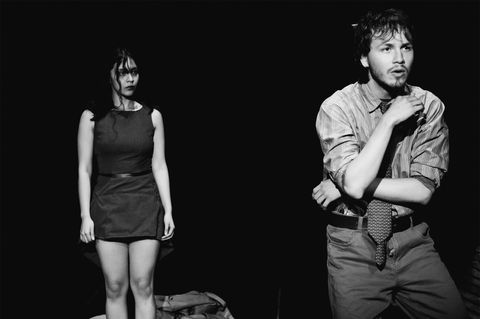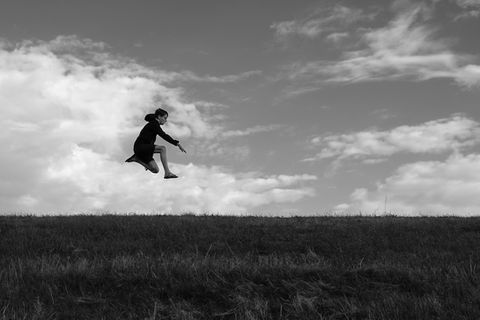
GOTHAM MEMORIES: NEW YORK CITY
(1969-2022)
January 6, 2023
INTERVIEW
PHOTOGRAPHY Jeff Rothstein
INTERVIEW Melanie Meggs
As the sun rises over the rooftops of New York City, Jeff Rothstein wakes up to start his day as an urban observer. With his cameras in hand, Jeff embarks on his journey to capture the streets of his beloved city, just as he has done for five decades. His passion for photography dates back to the dawn of the 1970s, when he first roamed the streets of Brooklyn as a native of the city.
A stroll down any given street transports us back in time, as each frame of Jeff's photos is carefully composed for the viewer to feel a part of his story. We witness life as it was through his viewfinder, from the mundane commutes to the liveliness of city life. His photos have become a treasure trove of nostalgia and a reminder of what this great city has been through over the years.
Over the years, Jeff’s photos have appeared in a variety of publications, including Black & White magazine, SHOTS, Street Photographers Notebook special monograph edition, London Evening Standard, Daily Mail, Mojo, YES. Yoko Ono exhibition catalog, URBAN Unveils the City And Its Secrets Vol. 7, and Fillmore East: The Venue That Changed Rock Music Forever.
Recent exhibitions include New York Public Library Mulberry St. branch, September-October 2022 (solo), Filter Space, Chicago, September-October 2022 (group), Black Box Gallery Online Annex, Portland, Or., September 2022 (group), ImageNation Paris at Galerie Joseph Le Palais, May 2022 (group), Porec Museum, Croatia, August–September 2021 (solo); H.P.F. Christopher, New York City, July 2017 (solo); and Winter, Analog Forever magazine, December 2019 (online group). His project Gotham Memories: New York City Images of the 1970s and 1980s won the Urban Photo Awards 2021 exhibition prize at the Poreč Museum (Croatia). Images from his book were picked as vintage award winners in Black & White magazine’s contests in 2019, 2020, 2021, and 2022. Jeff’s photobook, Today’s Special: New York City Images 1969-2006, was published by Coral Press Arts in June 2017, and is in the collections of many university and institutional libraries.
Jeff Rothstein has been able to capture New York City with such beauty and vibrancy that it’s hard to believe he’s been doing this for over fifty years. His commitment to documenting his city’s history is unparalleled and makes us appreciate the ever-changing yet timeless beauty of this stunning metropolis. Follow Jeff as he continues to wander around New York, and take a peek into its past and present through his lens.

“They are already memories once I press the shutter. These memories are at once mine and ours. Mine because they are what I have witnessed and captured with my camera. But they will be shared by all of us who know or have known the city intimately or casually or even remotely and vicariously. The photos are a record of history through a local eye. Many are evocative of the time and place of bygone eras, imbued with a timeless quality. The images in this portfolio span the years 1969 through 2022.”
IN CONVERSATION WITH JEFF ROTHSTEIN
THE PICTORIAL LIST: Welcome to The List Jeff, please tell us about yourself. What would you say first drew you to photography?
JEFF ROTHSTEIN: I was born and grew up in Brooklyn, New York, and lived there for many years. I’ve been living in Manhattan since 1988. I now devote all my time to photography.
I used to attend lots of baseball games and thought it would be fun if I bought a camera to take to the ballpark. So my getting into photography was really a means to an end.
TPL: How would you describe your photography, and what would you say you are always trying to achieve artistically?
JR: My genre is street photography. I try to have the viewer feel like they’re right there with me as part of the theater of the street.
TPL: Could you tell us what living in New York City has inspired in your work? What special qualities unique to the ‘Gotham City’ influence both your street and documentary photography and the way you portray your community?
JR: Being a street photographer, I feel fortunate to live here. The city’s not as gritty as it was when I photographed years ago, but there always seems to be subject matter just around the next corner. I think people can sense the fast and crazy pace of life here when they look at some of my images.
TPL: For the people who are not familiar with NYC, describe the atmosphere around you when you are photographing on the streets of NYC…the sensory perceptions that hypnotize and seduce you that constantly brings you back again and again.
JR: When I’m shooting the streets of New York City I feel that I’m on the ultimate stage, with life’s everyday dramas and comedies always being played out. I seem to be drawn to the chaos that surrounds me.
TPL: Did you ever think back then that you could be capturing an iconic era when you were photographing on the streets of NYC? In the future looking back at now, what do you think will be iconic about this era?
JR: You know, when I was out photographing back in the day, I didn’t really think about iconic or historical eras. I was just recording life as it was happening. It’s only when I had the perspective of passing time that I realized I was recording a city that no longer exists. I think the same answer applies to photographing this era.
TPL: What is the most rewarding part of being a photographer for you? What are some challenges that you have faced?
JR: The most rewarding part for me is when people appreciate my images, whether through exhibits, books or online articles. Most of the challenges have been self imposed. I took a long time to finally decide to do my first photobook, though people whose opinions I respect were telling me to do one for quite a while. Finally having the book published was the best thing that happened to my career.
When I’m shooting the streets of New York City I feel that I’m on the ultimate stage, with life’s everyday dramas and comedies always being played out.

TPL: Is it impossible for you not to be constantly on the lookout for a moment to be captured?
JR: Ha! Good question. I have to admit I’m always constantly scanning the streets looking for subject matter.
TPL: How do you manage a work/photography balance?
JR: I’m retired from previous jobs so photography is a full time pursuit for me.
TPL: Do you have any favorite artists or photographers you would like to share with us, and the reason for their significance?
JR: Robert Frank, William Klein, Garry Winogrand, Saul Leiter. Plus a few great street photographers that unfortunately some people aren’t as aware of. These include Sylvia Plachy, Frank Horvat, Louis Stettner, Louis Faurer, Frank Paulin. Also the early NYC photos of Alfred Stieglitz and the NYC Ashcan School of early 20th century artists.
TPL: What was the first camera you ever held in your hand, brought to eye, and released a shutter on? What is the camera you use now and your preferred focal length? Does the equipment you use help you in achieving your vision in your photography? Is there anything on your wishlist?
JR: When I was a kid, it was my family’s Kodak instamatics. My first proper camera was a Kowa SETR slr, which I bought in 1969. For many years, I just shot with film cameras (Nikkormat FTN, Nikon F2A, Nikon F3HP, Nikon FM2, Olympus XA, Olympus Stylus, Rollei AFM). I still use the F3HP, FM2A, XA and AFM. My preferred focal length is 35mm, but I also like 28mm. Years ago, I also shot with 50mm and 105mm quite a bit. A few years ago, a friend gave me a small, inexpensive digital point and shoot (one of the Canon powershots.) I’ve been using that for all my digital images so no, I really don’t believe equipment is that big a deal. It’s the photographer’s vision that really matters. That being said, I really should upgrade to a better digital camera (have my eye on a couple of Fujifilm cameras).
TPL: Are there any special projects that you are currently working on that you would like to let everyone know about? What are some of your photography goals? Where do you hope to see yourself in five years?
JR: I edited and sequenced my next book and now I’m trying to find a publisher. It’ll cover the same time span as my first book (1969-2006 New York City) but will have twice as many images. My goals are to produce more books and to continue to exhibit my work. Hopefully in five years I’ll still be photographing the streets of the city.
TPL: “When I am not out photographing, I (like to)…
JR: Go to art exhibits (my wife is an art historian), eat good food, watch film noirs, read, listen to music (60s and 70s rock and folk, jazz, classical, blues).

Jeff Rothstein's journey as an urban observer is a testament to the lasting power of photography and how it can serve to capture a moment in time. His dedication to capturing the beauty of his beloved city has afforded us a glimpse into its past, and provides us with a valuable window into its future. Through his work, we are called to go forth and appreciate the beauty of our cities, and how they are living works of art. We should take a page from his book and strive to capture the life of our cities in all its vibrancy and energy. We are challenged to be the observer and document our urban stories for generations to come.



















































